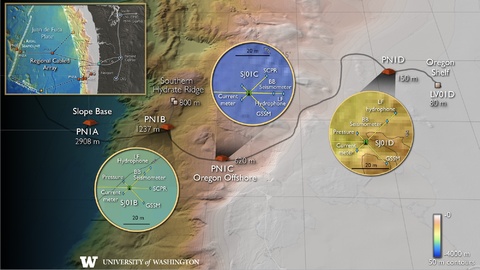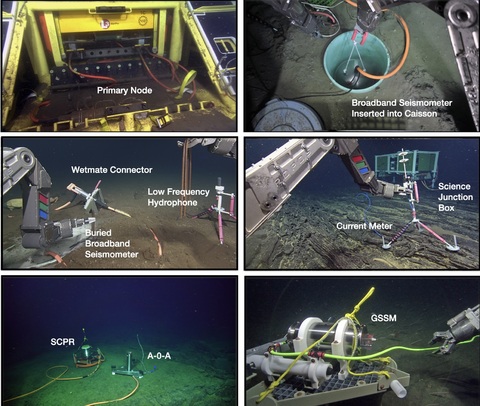Infrastructure and Instrumentation
The Ocean Observatories Initiative (OOI) Regional Cabled Array (RCA) has been operational since 2015 and consists of two telecommunication cables extending offshore from Pacific City, Oregon. One crosses the Juan de Fuca plate to Axial Seamount (an undersea volcano located about 300 miles offshore) and the other extends into deep water (about 9500 feet) and then wraps back to the south onto the continental slope and shelf off Newport, Oregon. There are seven nodes along the cable that host a variety of instrumentation at small seafloor substations.
Off the coast of Oregon, the OOI RCA has four nodes: One at the slope base on the subducting Juan de Fuca plate, two on the continental slope, and one on the outer continental shelf. Long extension cables connect two more sites on the Southern Hydrate Ridge (SHR) and the Oregon shelf. The Oregon Shelf site is located directly on top of one of two clusters of earthquakes offshore Oregon. Currently, geophysical instrumentation is limited to seismometers and seafloor pressure gauges at the slope base and SHR nodes.
The COSZO project will add seafloor science junction boxes connected by 200 meter cables to the nodes on the continental slope (PN1B, PN1C) and the continental shelf (PN1D), which will provide power and internet connectivity to ocean bottom seismic (OBS) packages that house a broadband seismometer, strong-motion accelerometer, and a digital recorder. A low-frequency (LF) hydrophone and differential pressure gauge (DPG) will be connected directly to each OBS package via 5 meter cables. An OBS package with a LF hydrophone and DPG will also be added to a preexisting science junction box at the Oregon Shelf site (MJ01C). A seafloor pressure gauge, ocean current meter, and a Geodetic and Seismic Sensor Module will also be installed at the three continental sites and a Self-Calibrating Pressure Recorder will be installed at PN1B and PN1C. Each new science junction box will also have 2-3 unused ports that will be available for additional instruments through PI-driven initiatives.
Science junction boxes connect to node sites along the RCA via 200 meter long cables. They are equipped with wet-mateable ports to provide low-voltage power and real-time internet connectivity to scientific instruments.
Instrument specifics: The science junction boxes are designed and manufactured by the University of Washington (UW) Applied Physics Laboratory Electronic & Photonic Systems Department. A description of existing science junction boxes on the RCA is available here.
The ocean bottom seismic (OBS) package houses a broadband seismometer, strong-motion accelerometer, and a digital recorder that collects and streams three-component seismic velocity and strong-motion acceleration time series in real-time. It can be used to search for and localize shallow tremor signals and very low frequency earthquakes, accurately localize earthquakes below the continental shelf, measure temporal changes in the velocity structure of the accretionary prism, and facilitate offshore earthquake early warning research.
Instrument specifics: The OBS package is a Nanometrics Atlantis Cabled Observatory (Model T360-COBST2) that includes a Trillium 360 ocean bottom broadband seismometer, a Class A Titan accelerometer, and a Centaur Gen5 datalogger within a titanium pressure vessel proven for deployment depths up to 6000 m. It has a dynamic range of 220 dB at 1 Hz, a 4 g acceleration clip level, and a noise floor below the Peterson Low Noise Model (Peterson, 1993) from 200 s to 10 Hz. Each OBS package is placed within a caisson, buried in the sediment, and covered in silica beads.
LF hydrophone and DPG data, when collocated with a broadband seismometer, can be used to better distinguish between seismic signals, such as tremor and acoustic arrivals such as the tertiary phases of T waves of oceanic earthquakes, and enable optimal corrections for tilt noise on vertical seismometer channels.
LF hydrophone instrument specifics: The HTI-90-U LF hydrophone has a frequency response ranging from 2 Hz to 20 kHz, a maximum operating depth of 6096 m, and a self-noise of 63 dB re 1 µPa.
DPG instrument specifics: The DPG (Cox et al., 1984) is depth rated for 6000 m and has a passband of 2 Hz to 500 s. The noise is 5 x 10-3 Pa**2/ Hz at 100 s.
High-resolution, uncalibrated seafloor pressure gauge time series can be used to search for and remove artifacts of pressure calibrations that might be confused with slow slip and to support measurements of compliance that are sensitive to changes in the seismic velocity structure.
Instrument specifics:
Three-component ocean current meter near-bottom current measurements can constrain oceanographic pressure gradients and thus contribute to pressure geodesy and to an understanding of seismic noise that might be confused with tremor.
Instrument specifics:
Self-Calibrating Pressure Recorder (SCPR) and Geodetic and Seismic Sensor Module (GSSM) collect time-series of calibrated pressure that can be used to measure secular vertical strain and detect slow slip events.
SCPR instrument specifics: The SCPR (Sasagawa and Zumberge, 2013) is designed and manufactured at the University of California San Diego Scripps Institution of Oceanography. It includes two redundant Paroscientific quartz pressure gauges (Model 42 K) that are periodically switched between the ocean pressure signal and a stable, reproducible reference pressure generated by a DH Instruments piston gauge (Model PC-7300-2) onboard the instrument using motor-driven Swagelok valves (Series 41G) turned by Hanbay motorized actuators (Model MDM1000). The sensors measure the shift in the resonant frequency of a quartz force transducer attached to a Bourdon tube as the applied pressure changes with a sensitivity of order 0.005 kPa. The system instruments and electronics are housed in a titanium housing, which also hosts a temperature sensor.
GSSM instrument specifics: The GSSM (Wilcock et al., 2021) is an instrument designed and built by the UW Applied Physics Laboratory that utilizes a Paroscientific Seismic Oceanographic Sensor module (Models 7116-2K-2 (1400 m depth) and 7116-1K-2 (700 m depth)) comprised of two Paroscientific Digiquartz pressure transducers (Model 44.4K-302; maximum depth rating of 1400 m, range of 0-4400 psi, and accuracy of 0.01% of full scale with parts per billion resolution possible), a Paroscientific Digiquartz nano-resolution barometer (Model # 6000-16B), and a Paroscientific Quartz Seismic Sensor 1.5 g accelerometer (Model QA-15). It employs the A-0-A method where two pressure transducers are periodically switched using a VICI HPLC valve (Part # C52-3304IA-UWA) within the titanium pressure housing from measuring external water pressure to measuring the internal housing pressure for calibration. The housing also contains a temperature sensor to measure and correct for thermal effects.
References
Charles Cox, Thomas Deaton, and Spahr Webb. A Deep-Sea Differential Pressure Gauge. Journal of Atmospheric and Oceanic Technology: Vol. 1, No. 3, pp. 237–246, 1984. (PDF, 688 KB)
Jon Peterson, Observations and Modeling of Seismic Background Noise, Open-File report 93-922 (Albuquerque, New Mexico: U.S. Department of Interior Geological Survey, 1993)
Glenn Sasagawa and Mark A. Zumberge. A Self-Calibrating Pressure Recorder for Detecting Seafloor Height Change. IEEE Journal of Oceanic Engineering: Vol. 38, pp. 447–454, 2013.
William S. D. Wilcock et al. A Thirty-Month Seafloor Test of the A-0-A Method for Calibrating Pressure Gauges. Frontiers in Earth Science: Vol. 8, 2021, doi: 10.3389/feart.2020.600671.



